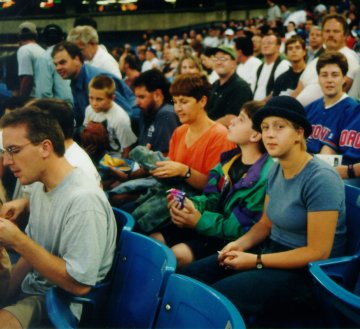Look out Yankees!
The Ripken Curse Continues
Ask Not for Whom the Belle Tolls.
The best division in baseball right now is the American League East, and the best team in the American League East is the New York Yankees. In fact, a lot of baseball writers have already wrapped up the championship and handed it to the pinstripers.
Not so fast. Will the Yankees repeat?
Well, they look pretty solid. But the Yankees last year didn’t really have a single player who was as good as Sosa, McGuire, Griffey, or Roger Clemens. (This year, they have Roger Clemens.) So why did they win so many games? Almost every player in their line-up had a great year. Paul O’Neill, David Wells, Bernie Williams, Tino Martinez…. That’s what happened to Minnesota in ’91, and the Blue Jays in ’93. They had a bunch of players that simply had a great year at the same time.
The Blue Jays won the World Series in 1992 on talent. That was different. They had the best players and these players played the way they were expected to. They deserved to win. But in 1993, the Blue Jays—a completely different team (minus Gruber, Key, Henke, Winfield, Morris; plus Molitor, Henderson, Sprague, Fernandez)—won because a lot of their players had career years. Philadelphia was in the World Series that year for largely the same reason. Atlanta lost to Philadelphia in the playoffs because the best talent does not always win.
The bottom line: you win in baseball when you have enough talented players having good years to beat the other team’s talented players having good or so-so years. Without the raw talent on the bench, all the grit and determination in the world is not going to take you anywhere.
Injuries are not as critical as reporters would have you believe. The difference between the best first baseman in the league (Mark McGuire) and an average first baseman is not the difference between 70 homeruns and no homeruns. It’s the difference between 70 homeruns and 40 homeruns. Over an entire season, that is ¼ homerun a game. How many games are decided by one or less runs? How many of those games would have ended differently had Mark McGuire been at first base instead of John Olerud? Not as many as you might think. That’s why St. Louis didn’t even make the playoffs. Mark McGuire alone isn’t going to get you there. I’m not saying he isn’t effective– I’m just saying that he can’t do it alone.
I’m not sure the Yankees are going to be as fortunate this year as they were last year. The Yankees have three or four great players this year: Clemens, Derek Jeter, Bernie Williams, and Ramiro Mendoza. Then they have a string of superior players, including Tino Martinez, Paul O’Neil, Livan Hernandez, and Chuck Knoblauch. Well, yeah, the truth is, that’s a pretty impressive line-up. Cone and Hernandez can pitch, but Cone is 34 now and not as strong as he used to be. Pettite can pitch, but is he healthy? Jorge Posado is young and strong—how good will he be in September?
Well it’s early. They’ve picked up where they left off. They will play pretty well at times this season. But I’m not sure that, over the stretch of 162 games, this line-up is quite as durable as many people think it is. Most people never noticed it, but the Yankees were not the best team in baseball, or even in the American League, over the last two months of the 98 season: the Blue Jays were. And the Blue Jays whipped the Yankees in September.
I don’t expect Boston to continue their string of early success. After all, they are Boston. After Martinez, the pitching is pretty thin, and with the injury to Noamar Garciaparra and the absence of Mo Vaughn, they’re going to finish no better than third. More likely they’ll finish fourth. [this was written before Boston lost 4 straight].
Baltimore chose to spend big bucks on free agents, but, as usual, spent the money on players who were well-known for having had great years in the past. The trick is to spend that kind of money on players who are about to have great years, like Chris Carpenter, or Vladimir Guerrero. Baltimore will finish fourth.
This is why Montreal often does much better than expected: their scouts and coaches are good at identifying players who are going to command big salaries because they play well. That is why Baltimore is so BAD. Their coaches and scouts are really good at identifying players who have already had their best years, and, therefore, are in decline. In fact, they have an icon of a role-model right there on 3rd base: Cal Ripken, the most vastly over-rated player in the league.
Can you believe that the Dodgers signed 34-year-old Kevin Brown for 7 years for $85 million? Is this some kind of joke? Brown won’t be around for five years, let alone seven. Let’s say Brown, like almost every other pitcher in the history of the game, begins to lose his effectiveness in three years. What are you going to do? How are the Dodgers going to be able to pay replacement talent when they’re on the hook for $10 million a year for a pitcher who can’t play?
The Blue Jays have the pitching and offence to threaten even the Yankees, provided that one or two players like Jose Cruz and Alex Gonzalez have breakthrough years. I think it was a mistake to let Canseco go and then bring in Geronimo Berroa. I thought Canseco had reached a new stage in his career where he might avoid stupid injuries and provide a productive bat from the DH spot. I don’t like Canseco’s strikeout ratio but he will probably hit another 40 homeruns this year, and that is enormous offense, and who needs Geronimo Berroa? Still, the Blue Jays have Delgado, Greene, and Stewart, and Fletcher is a solid catcher. Tony Fernandez proved last September that he is still one of the best clutch hitters in the game, and Alex Gonzalez may be one of the two or three best defensive shortstops in the league. When your fifth starter leads the league in ERA and you have to put a guy who had a no-hitter going into the 9th inning last fall (Roy Halladay) into the bullpen, you’ve got a chance to scare a few people.
When the Yankees play Minnesota, you have about $80 million in talent playing about $8 million. There is no way that baseball is going to remain competitive with this kind of system, unless we get more owners like Marge Schott and Peter D’Angelos. But most owners are smarter than they used to be. George Steinbrenner used to squander all his money on players like Joe Girardi and Jesse Barfield. Lately, he squanders his money on players like Chuck Knoblauch and Bernie Williams instead. Why should the fans in Minnesota continue to pay $30-$50 to come out and watch their team get pummeled by athletes that make ten times as much as their players do? What chance do they have?
A word about Cal Ripken. I said many years ago that Baltimore will never win a championship as long as Cal Ripken is on that team. It was not so much that he was a bad player (though he was vastly over-rated) as it was that the entire culture of the Baltimore Orioles baseball club, with fawning owner Peter D’Angelos, centred on THE STREAK rather than THE WORLD SERIES. The focus of the team was Ripken’s achievements, not Baltimore’s. So what does Baltimore do in the off-season? They sign Albert Belle and Will Clark! They let Roberto Alomar, one of the two or three most valuable all-round players in the game, slip away to Cleveland (which is 8-1 or something as we speak).
I also find Ripken rather phony anyway. He goes around acting modest and self-effacing, while he sucks up to all the media attention like a leech. How much do you want to bet that when he retires he’s going to get one of these grand tours of all the major league cities? For classy exits, see Wayne Gretzky. “Hello? Sunday’s my last game. Nice seeing you.”
If the Blue Jays are in contention come August, look for them to trade a prospect or two for a DH or, possibly, a closer. I’m not convinced by Person yet. I liked Escobar there more. Look for Atlanta to try to talk Montreal out of Urbina. They’d be stupid not to try.



